You’ll find PVA water-soluble supports excel for complex geometries with PLA and PETG, dissolving completely in warm water without manual removal. HIPS performs best for high-temperature materials like ABS and ASA, requiring limonene for clean detachment. Ionic Hi-Temp combines water-soluble and breakaway capabilities for engineering-grade filaments under extreme heat conditions. Standard breakaway supports using the same material as your model guarantee clean separation and professional surface finishes. The following thorough analysis reveals ideal pairing strategies for each application.
Understanding Breakaway Support Material Properties and Applications
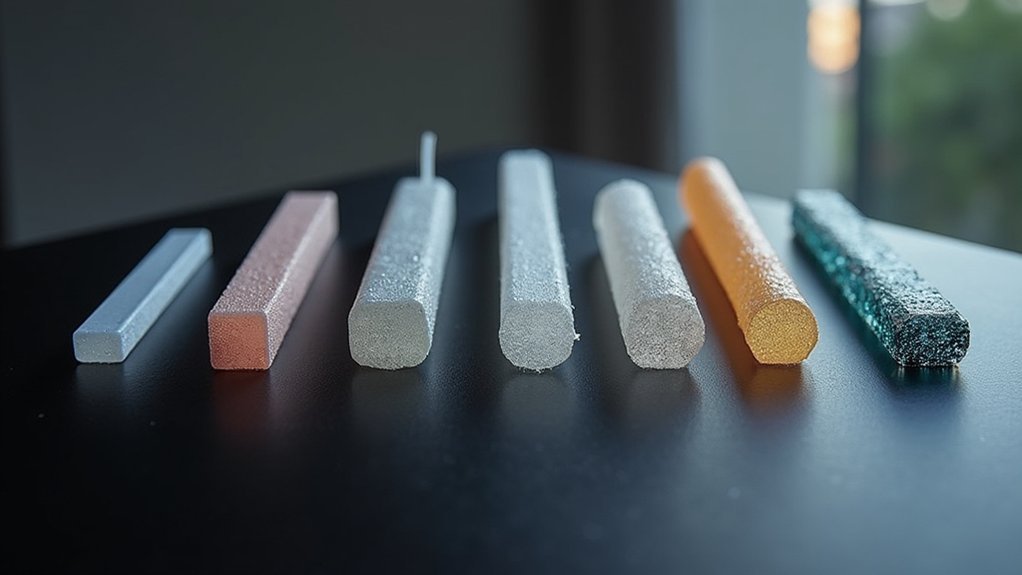
Precision becomes critical when selecting breakaway support materials, as these supports use the same filament type as your primary model while maintaining the ability to detach cleanly after printing.
You’ll achieve excellent compatibility with materials like PLA, PETG, and ABS without compromising your print’s structural integrity.
Your breakaway support won’t permanently bond to the print surface, preserving the surface finish quality you need for professional results.
Breakaway supports maintain clean detachment from your model, ensuring professional-grade surface finishes without permanent bonding or quality compromise.
These supports excel in intricate designs where you need quick removal without tools damaging delicate features.
However, you’ll find they bond more strongly than soluble alternatives, requiring careful planning for access points.
Adjusting the distance between support and model prevents unwanted adhesion while ensuring peak performance throughout your printing process.
PVA Water-Soluble Support Material Performance Analysis
You’ll want to understand how quickly PVA dissolves under different conditions to optimize your post-processing workflow.
Temperature plays an essential role in dissolution speed, with warmer water markedly reducing the time needed to remove supports completely.
Testing various water temperatures will help you balance efficiency with potential risks to your printed parts.
Dissolution Speed Testing
When testing PVA’s dissolution speed, you’ll find that water temperature dramatically affects how quickly your support material breaks down. Higher temperatures accelerate the dissolution rate considerably, reducing your post-processing time compared to standard room-temperature water.
This dissolvable support typically outperforms other soluble materials in speed tests, making it efficient for complex geometries.
Before testing, verify your PVA is properly dried to avoid performance issues during printing. The material works exceptionally well with various filaments including PLA, Tough PLA, Nylon, PETG, and TPU.
Your printing temperature settings won’t negatively impact PVA’s dissolution capabilities, and you’ll notice minimal surface quality degradation on your final prints. This combination of fast dissolution and clean removal makes PVA ideal for intricate support applications.
Temperature Performance Results
Although PVA’s ideal printing temperature ranges from 190°C to 220°C, your specific printer settings and filament combinations will determine the exact temperature that delivers the best performance results.
Temperature performance testing reveals PVA’s exceptional compatibility across multiple filament types. When you’re printing Tough PLA or standard PLA, maintaining consistent temperatures guarantees proper layer adhesion to your printing surface while preventing warping or delamination.
Key temperature performance factors include:
- Thermal stability – PVA maintains structural integrity throughout the temperature range without degrading.
- Filament compatibility – Works seamlessly with PLA, PETG, TPU, and Nylon at their respective printing temperatures.
- Impact resistance – Higher temperatures within the recommended range improve support strength during printing.
You’ll achieve ideal results by calibrating temperatures based on your primary filament’s requirements, ensuring both materials bond effectively while maintaining easy water dissolution post-printing.
HIPS High-Temperature Support Material Capabilities
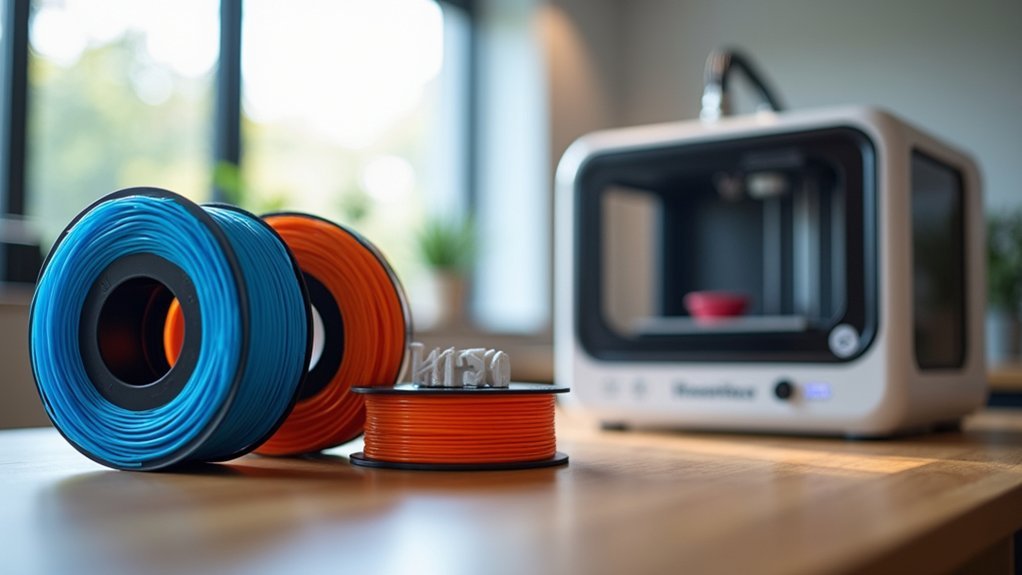
HIPS (High Impact Polystyrene) excels as a breakaway support material for high-temperature printing applications, particularly when working with ABS and ASA filaments.
HIPS delivers superior breakaway support performance for high-temperature 3D printing with ABS and ASA materials.
You’ll find that HIPS aligns perfectly with these materials’ printing temperatures, minimizing warping while ensuring strong adhesion between your build material and support structures. This temperature compatibility makes HIPS one of the most reliable support materials for creating durable parts.
Unlike water-soluble alternatives, you can’t dissolve HIPS supports. Instead, you’ll need limonene for removal—a non-toxic, non-corrosive, and biodegradable solution.
HIPS maintains excellent surface finish quality and won’t permanently bond to your printed part. You’ll appreciate how easily these supports remove with proper tools, making HIPS ideal for scenarios requiring robust support structures without compromising your primary print’s quality and integrity at high temperatures.
Ionic Hi-Temp Hybrid Support Material Features
You’ll find Ionic Hi-Temp Hybrid Support Material combines the best of both worlds with its dual water-soluble and breakaway capabilities.
This support material excels at high temperatures, making it perfect for challenging prints using nylon, ABS, and PETG filaments.
Its water-dissolving properties streamline your post-processing workflow while maintaining exceptional adhesion during the printing process.
Water-Soluble Properties
When printing complex geometries with high-temperature materials like nylon or ABS, Ionic Hi-Temp Hybrid Support Material’s water-soluble properties offer a distinct advantage over traditional breakaway supports.
You’ll find this dual-functionality particularly valuable when dealing with intricate overhangs and internal cavities that would be difficult to access manually.
The water-soluble properties provide three key benefits:
- Complete dissolution – You can remove support material from tight spaces without damaging delicate features.
- Time efficiency – Water dissolution eliminates tedious manual removal from complex internal structures.
- Surface quality – You’ll achieve smoother finishes compared to mechanical breakaway methods.
This Support Material maintains its breakaway characteristics for accessible areas while offering water dissolution for challenging geometries.
The result is prints with high strength and durability that retain their engineering-grade integrity throughout the support removal process.
High-Temperature Compatibility
Since high-temperature materials like nylon, PETG, and ABS require elevated printing temperatures that can compromise standard support materials, Ionic Hi-Temp Hybrid Support Material’s thermal stability becomes essential for successful prints.
You’ll find this support material maintains its structural integrity under high heat conditions, preventing warping or degradation during the printing process.
When working with ABS and other high-impact build materials, you can rely on Ionic Hi-Temp Hybrid to provide consistent support throughout extended print cycles.
Its formulation specifically addresses the challenges of elevated temperature printing, ensuring your complex geometries maintain dimensional accuracy.
You won’t experience the common failures associated with standard supports when printing engineering-grade filaments that demand robust thermal performance.
Standard Breakaway Support Material Comparison

Although each standard breakaway support material offers distinct advantages, understanding their comparative strengths will help you select the right option for your specific printing needs.
When comparing standard breakaway support materials, you’ll find three primary options that excel in different scenarios:
- PLA – Offers the easiest printing experience with low temperatures and minimal warping, making it perfect for beginners and detailed models requiring precise support removal.
- PETG – Provides excellent chemical resistance and flexibility while maintaining good breakaway properties, ideal for functional parts that need durable support during printing.
- ABS – Delivers superior strength and heat resistance, though it requires higher temperatures and may need tools for efficient support detachment from your models.
Each material maintains compatibility with your build filament while ensuring clean surface finishes.
Material Compatibility and Pairing Recommendations
Your choice of breakaway support material must align with your build filament to achieve ideal printing results.
Material compatibility spans PLA, Tough PLA, ABS, Nylon, CPE, CPE+, and TPU 95A, giving you flexibility across diverse projects.
When pairing filaments, you’ll get best results using the same material for both build and support structures, ensuring consistent surface finish with minimal post-processing.
For strength and durability considerations, adjust support-to-model distance carefully, especially with tougher materials like Nylon to prevent permanent bonding.
Optimize your print settings including nozzle temperature and bed adhesion methods for each filament type.
With challenging designs requiring enhanced strength and durability, keep removal tools handy to detach breakaway supports effectively without damaging your primary model.
Support Removal Techniques and Post-Processing Methods
When you’re ready to remove breakaway supports, start by identifying natural separation points where the support material meets your printed model.
You’ll need tools like pliers or craft knives for clean removal without damaging your print. Adjust your slicer’s support distance settings beforehand to minimize adhesion between supports and the model.
Effective support removal techniques include these methods:
- Heat application – Use heat guns cautiously to soften breakaway support materials, making detachment easier while avoiding overheating.
- Mechanical removal – Carefully pry supports away using appropriate tools at separation points.
- Post-processing refinement – Sand or file remaining marks for smooth finishes.
After removal, focus on cleaning the model thoroughly.
Rinse with soap and water or use isopropyl alcohol to eliminate residue. These post-processing methods guarantee your final print achieves professional-quality appearance and surface finish.
Frequently Asked Questions
How Much Does Each Breakaway Support Material Cost per Kilogram?
You’ll find breakaway support material costs vary considerably by type and brand. PVA typically costs $40-80 per kilogram, HIPS runs $25-50, and specialized water-soluble supports can reach $100-200 per kilogram.
Which Breakaway Support Materials Are Environmentally Friendly and Biodegradable?
You’ll find PVA and HIPS are biodegradable breakaway supports that dissolve in water or break down naturally. PLA-based supports also offer eco-friendly options, decomposing in industrial composting facilities within months.
What Is the Typical Shelf Life of Unopened Breakaway Support Filaments?
You’ll find most unopened breakaway support filaments last 1-2 years when stored properly in cool, dry conditions. PVA-based materials typically have shorter shelf lives than HIPS or PET-based supports due to moisture sensitivity.
Can Breakaway Support Materials Be Recycled or Reused After Printing?
You can’t easily recycle most breakaway support materials through standard programs. However, you can reuse removed supports by shredding and re-extruding them, though this degrades material properties considerably.
Which 3D Printer Brands Are Specifically Compatible With These Support Materials?
You’ll find breakaway support materials work with Ultimaker, Prusa, MakerBot, and Raise3D printers. They’re also compatible with Zortrax, BCN3D, and most dual-extruder machines that support PVA or HIPS filaments.

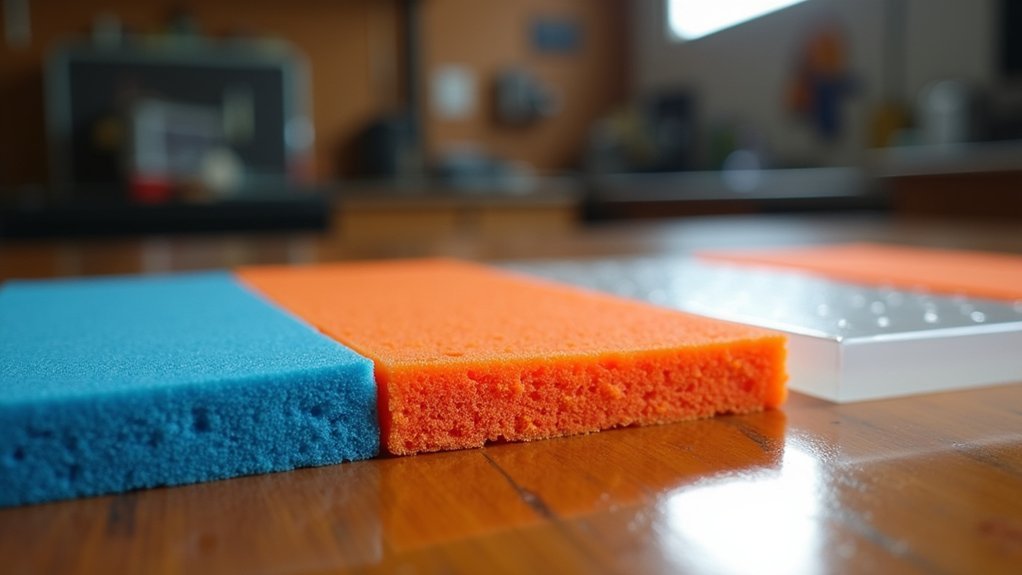
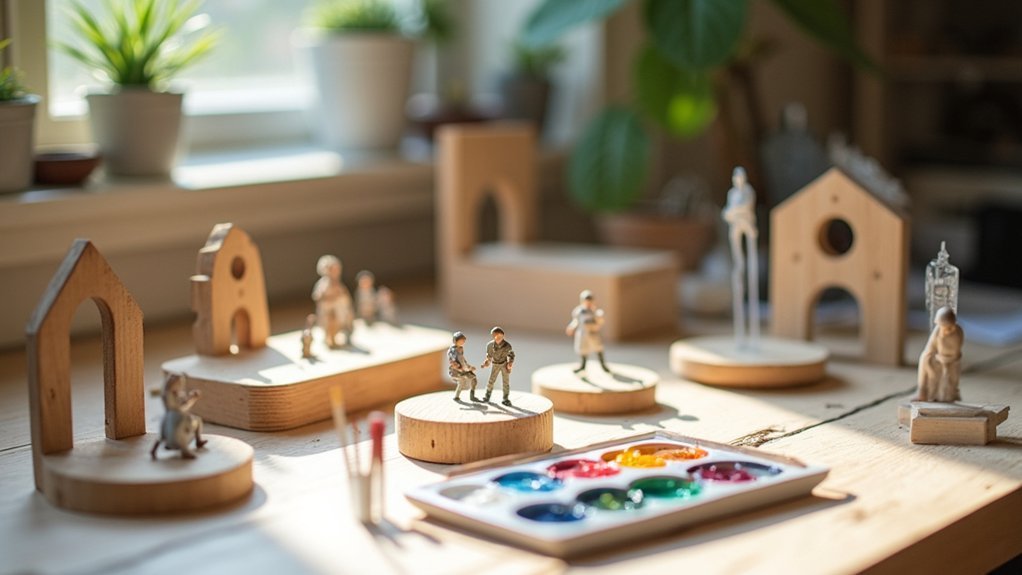
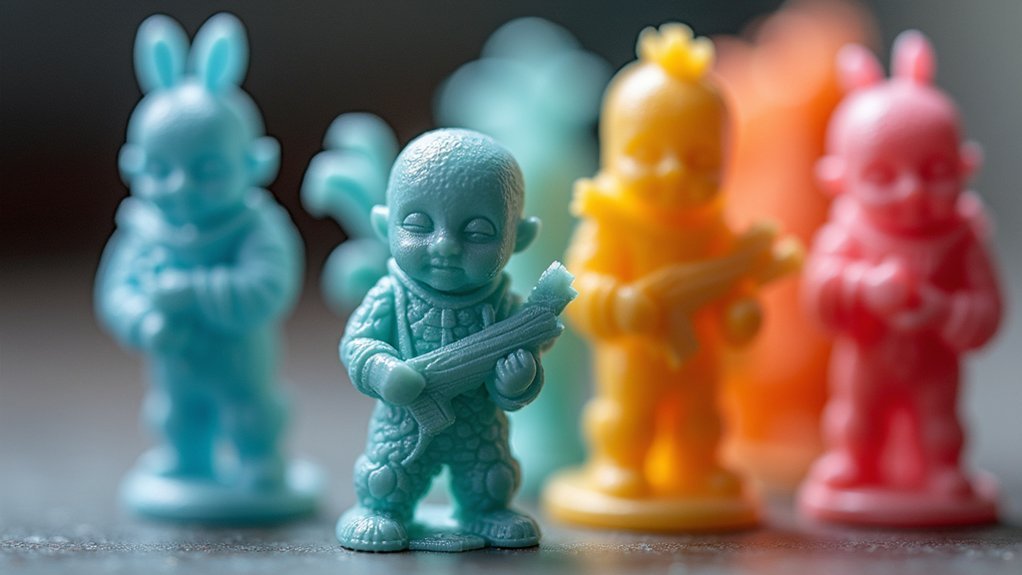

Leave a Reply